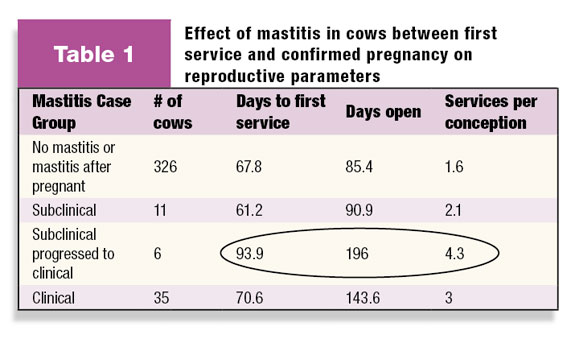The battle with mastitis has always been an on-going, difficult challenge for the dairy producer. Research shows that in addition to the $150 economic loss per diagnosed case of mastitis from discarded milk, antibiotic treatment, decreased production and time spent managing treatment, mastitis also takes a toll on the dairy cow’s reproductive success. Several studies support the detrimental effects of mastitis, including research from the University of Tennessee. This study’s objective was to identify the presence and strength of the relationship between mastitis and reproduction within a 758-cow Jersey herd. Reproduction data was collected and analyzed over a 10-year period.

Table 1 details the conclusions of the study. Cows diagnosed with mastitis experienced significantly greater days open and services per conception compared to cows with subclinical or no mastitis. Furthermore, cows with subclinical infections that eventually became clinical cases during the breeding period were most affected, as circled in the table.
Other studies done to probe the correlation between mastitis and reproductive health concluded a cow’s response to mastitis caused by gram-negative pathogens has a negative effect on hormone levels and follicular development. Further research suggests that prostaglandins are released in the inflammatory response to gram-negative infections, which can alter the length of the estrous cycle and possibly cause the loss of a developing embryo.
Supplemental to this research, studies at the University of California – Davis found cows developing mastitis during any period of their lactation showed an increase in abortions between 42 and 180 days after service, and cows that had mastitis even before first postpartum insemination were more likely to lose the pregnancy. Increased incidence of abortion significantly increased the calving-to-conception interval. Findings from these studies carried out at the University of California – Davis are further supported by additional U.S. studies.
The link between mastitis and reproduction
Researchers have found that the following detrimental effects of mastitis can have a variety of negative consequences for breeding pen success:
• Elevated body temperature, possibly resulting from both gram-negative and gram-positive infections of the mammary gland. Increased body temperature results in decreased feed intake and greater loss of body condition, leading to a more pronounced negative energy balance and delayed ovarian cycling.
• Endotoxins from mastitis bacteria cause increased blood concentrations of cortisol, a hormone that blocks the release and peak of luteinizing hormone (LH) secretions. This blockage compromises follicle and oocyte development, depresses ovulation and creates suboptimal luteal function.
• Production of cytokines. Cytokines can stimulate the production of PGF2α, consequently leading to premature luteolysis and resulting in embryonic death or abortion.
• Prostaglandins in the blood. There is a correlation between the increased concentrations of nitric oxide (NO) and prostaglandin F2α (PGF2α) in milk. Mastitis-infected cows challenged with oxytocin had increased blood concentrations of PGF2α metabolite, which indicates an infection of the mammary gland and can possibly result in a systemic response that disturbs fertility.
Researchers also suspected that the lengthy interval from calving to first postpartum service may be the result of an extended period of anovulation following calving caused by reduced energy balance due to fever or blockage of GnRH-LH secretion. Fever also leads to the poor production of embryos through exposure of harmful compounds to their development, significantly increasing services per conception and resulting in possible embryonic loss or abortion.
To improve herd reproduction, mastitis management should be a top priority on the dairy. Through these research studies, it has been shown that lowering the cases of mastitis in your herd will not only increase herd profitability, but also improve reproductive performance.
Managing mastitis, improving reproduction
In an effort to control mastitis and improve breeding success, the National Mastitis Council recommends its 10-step mastitis control program:
1. Establish udder health goals for your herd.
2. Maintain a clean, comfortable environment.
3. Use proper milking procedures.
4. Properly use and maintain your milking equipment.
5. Keep good records.
6. Manage clinical mastitis appropriately during lactation.
7. Use effective dry cow management.
8. Use biosecurity protocols to prevent the spread of contagious pathogens and when marketing chronically infected cows.
9. Monitor your herd’s udder health status regularly.
10. Review your mastitis control program periodically.
While mastitis prevention is likely already active in your herd, it is important to follow these steps to not only decrease the production and financial downfalls of mastitis, but to improve the reproductive health of your herd. PD
References omitted due to space but are available upon request by sending an email to editor@progressivedairy.com .
— Excerpts from Dairy Cattle Reproduction Council newsletter, Vol. 6, No. 2
To improve herd reproduction, mastitis management should be a top priority on the dairy. Photo by PD staff.





